Chip in Now to Stand Up for Working People
Working people need a voice more than ever and Working America is making that happen.
Working people need a voice more than ever and Working America is making that happen.

02/04/2020
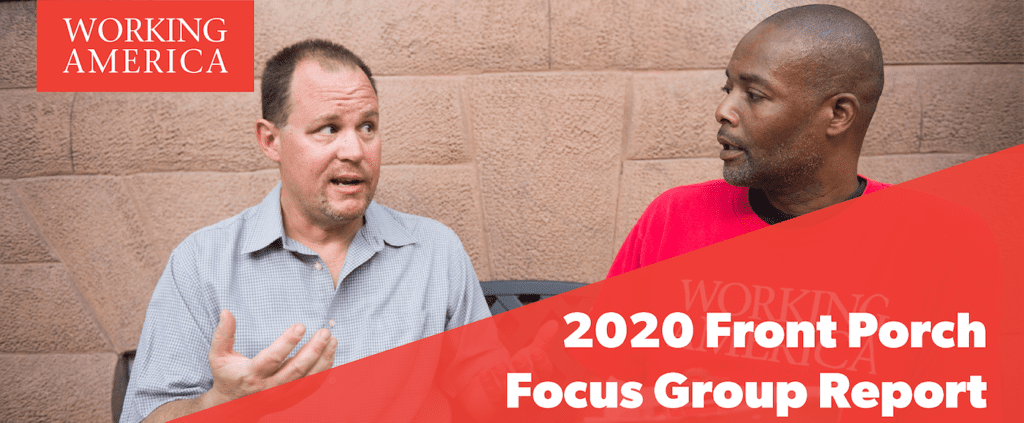
As the 2020 election rapidly approaches, everyone is focused on one question: What are President Trump’s odds of being reelected? Trump won the presidency with razor-thin margins; just over 100,000 voters in Michigan, Wisconsin and Pennsylvania secured his Electoral College victory. To prevail, progressives need to both turn out Democratic base voters and persuade those voters who swung toward Trump in 2016. How can progressives earn their support in 2020?
Building on our series of in-depth, large-scale field surveys called Front Porch Focus Group reports, Working America completed a new survey of 1,153 persuadable and Democratic-leaning infrequent voters. From December 17, 2019, through January 17, 2020, we spoke with these voters in five of the battleground states: Arizona, Michigan, Minnesota, Pennsylvania and Wisconsin. In an online survey of Working America’s long-term panel conducted from January 3 to 8, 2020, we reinterviewed 1,920 working-class voters whom we have tracked since the 2016 cycle.
Working America’s team of professional canvassers held in-person conversations with 390 Democratic base voters and 762 voters we identified as being open to persuasion through the unique Working America model. These Democratic base voters were working-class people of color — African-American and Latinx. To identify persuadable voters, we combined analysis of dozens of our randomized clinical canvass trials conducted during elections over the last decade. The resulting persuasion model identifies the likelihood of a voter changing candidate preference because of conversations with our canvassers. These segments of voters are just the sort that Democrats need to engage and win over.
This report is a continuation of work we began in January 2016, when canvassers sought to understand the emerging appeal of Donald Trump by speaking with more than 1,600 white working-class voters in neighborhoods outside Cleveland and Pittsburgh. At a time when pundits were writing of Trump’s candidacy as a publicity stunt, we uncovered his popularity among Republican base voters, as well as his cross-party appeal among traditionally Democratic voters.
In this latest report, we sought to understand where voters stand on issues and how they are processing the current political moment through qualitative and quantitative data gathered from in-person conversations and through an online survey of Working America’s long-term survey panel.
In 2020, persuadable voters in key battleground states — Arizona, Michigan, Minnesota, Pennsylvania and Wisconsin — areas receptive to a wide range of progressive policies as the Democratic base. The policy details of the Green New Deal or expanding the Affordable Care Act matter less to voters than the need to take action. Three years of the Trump era has failed to address the urgent need for change felt by many of the swing voters who took a chance on him in 2016. Indeed, these voters voice support for progressive policies like protecting and improving the Affordable Care Act (50%), making it easier to form a union (59%) and aggressively tackling climate change, which they expressed as support for a Green New Deal (61%). Yet there were also areas where these voters were relatively less supportive of progressive policies like Medicare for All (35%) and right-wing policies like building a wall on the border between the United States and Mexico (39%).
Fissures in Trump’s support emerge among the working class. One in four 2016 Trump voters (23%) do not back him in our online survey. When canvassers dug into the impact of Trump’s first term, most people said that it either made no difference or hurt their family. Even 1 in 5 of those who told us Trump’s first term in office “helped” their family say they plan to vote for the Democratic nominee. While Trump’s support seems to have hardened among his remaining supporters, his base of support appears to have contracted, rather than expanded.
The Democratic base is galvanized against Trump. In our online survey, 2016 Clinton voters and those base voters who skipped 2016 say overwhelmingly (86%) they are unified behind whoever the Democratic nominee turns out to be. Despite pundits’ concerns with the potentially divisive impact of a Democratic nominating contest, these voters are not turned off from participating in the 2020 election
The Trump tax plan is remarkably unpopular, showing surprising potential for voter persuasion against him. Our face-to-face conversations revealed that Trump’s tax plan has very little support. In fact, working-class people described, in concrete terms, how they were personally affected or did not feel tangible benefits of the tax code overhaul. Regardless of party affiliation, the bill piqued voters’ sense of fairness because the bill disproportionately benefited the rich. Engaging with voters on the Trump tax bill could prove to be a promising approach for progressives looking to win persuadable voters.
Place and race matter. Geography—particularly the rural-urban divide—and race animated the partisan polarization of 2016. Small towns moved decidedly toward Trump while big metros shifted toward Democrats. A stark racial polarization was evident. Voters in these communities, however, show the opportunity to build a common agenda.
• Rural: In rural communities, health care (21%) and the economy (12%) topped concerns, but climate change was cited by 1 in 10 persuadable rural voters as their top voting issue.
• Suburban: More affluent suburban voters show tepid support of policies like Medicare for All (41%); however a clear majority support protecting the ACA (56%).
• Urban: Despite macroeconomic indicators (wage growth, declining unemployment, etc.) showing positive growth in urban areas, Democratic base voters do not feel the gains. This group has the smallest share of voters saying they are confident (34%) in their economic future of anyone we spoke with
• Race: Racial divides have often defined our politics. On matters such as building a border wall and Medicare for All, our data show that race is strongly predictive of support or opposition for these policies. For example, voters of color are only about one-third as supportive as white voters of building a wall. But on other issues like expanding the ACA, addressing climate change and expanding the right to form a union, our data show there was strong cross-racial appeal.
The majority of voters we spoke with believe that Trump has committed acts that are grounds for his impeachment, but many excuse his behavior as typical of politicians. Our conversations on impeachment track public opinion polling of support versus opposition. But what stands out from our vantage point on the ground in working-class communities is the number of people who are planning to vote for Trump in 2020 and believe he’s committed impeachable offenses (11%). The sentiment, regardless of the voter’s partisan preference, casts a cynical view of politicians broadly. As one voter said, “They’ve all done something wrong.”
In 2020, persuadable voters in key battleground states — Arizona, Michigan, Minnesota, Pennsylvania and Wisconsin — are uncertain about whom in politics to trust, but are as receptive to a wide range of progressive policies as the progressive Democratic base. The policy details of the Green New Deal or expanding the Affordable Care Act matter less to voters than the need to take action.
We asked voters for their opinion on various policy proposals at the center of discussion in 2020. The chart below shows the answers to these questions, with responses sorted by Democratic base and modeled persuadable voters.
For both Democratic base and persuadable voters, there is strong support for the Green New Deal; making it easier to form a union; and building on the Affordable Care Act. While Medicare for All is overwhelmingly popular with Democratic base voters, only roughly 1 in 3 persuadable voters expressed support.
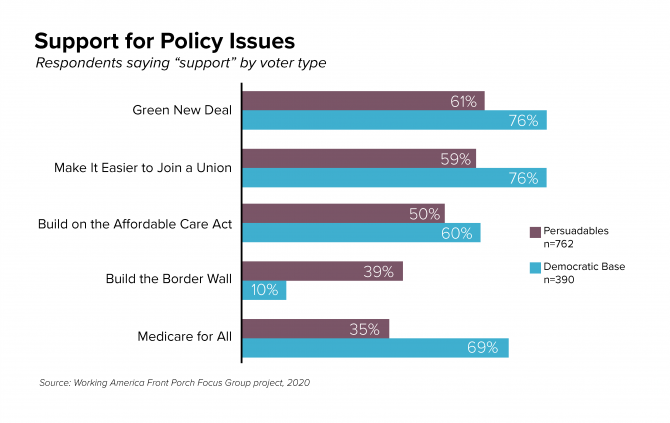
Nevertheless, these findings present heartening signs for progressives, and our conversations with persuadable voters echoed this sentiment. While we did encounter a segment of voters who responded to proposals for building on the Affordable Care Act or the Green New Deal with Fox News-inspired talking points, many voters spoke about the urgent need for action on health care and climate change.
The debate is settled for the majority of people we spoke with—everyone in America deserves access to health care. Voters frequently made comments like “everyone needs health care,” or “we have to do something” to secure universal health care coverage. David, a 30-year-old white man in Bristol, Pennsylvania, told our canvasser, “If you lose a job, it’s scary; you might not have health care for a few months until you find a new one, and then, oops, your savings are gone.” Andrea, a 62-year-old white woman and Philadelphia, Pennsylvania, resident, said she supported Medicare for All “because everybody needs to see a doctor.”
Kent, a 69-year-old white man and Wayne County, Michigan, resident is representative of a broader group of voters we encountered. Kent, who approved of the job Trump is doing, told our canvasser that he was opposed to the repeal of the Affordable Care Act and ultimately supported Medicare for All, adding, “Everyone should be able to go to the doctor when they’re sick.” He described how he and his wife struggle to pay $144 per month each from their Social Security checks for insurance coverage.
Similarly, Derek, a 36-year-old white man in Phoenix, Arizona, identified as an independent and said he voted for Trump in 2016. Nevertheless, he told our canvasser that he supports Medicare for All, saying, “I have children, and coverage is very expensive and seems to be rising. The government needs to take care of the working class.”
Demands for bolder proposals extended to Democratic base voters as well. Stacey, 33, a white woman and Center Line, Michigan, resident, spoke about the need for universal health care. Stacey said, “People are dying due to no insurance, and even when they do [have insurance], the insurance companies often deny coverage or procedures.” Marcela, a 67-year-old Latinx woman in Minnetonka, Minnesota, said, “You should not be able to make money of health care; people need care. It feels like we are in the Dark Ages.”
Climate change provided a stronger consensus between persuadable voters and the Democratic base. In discussions about climate change and the Green New Deal, our canvassers asked if voters supported or opposed a “Green New Deal that commits to 100% renewable energy within 10 years,” and they were struck by how often Trump-supporting or undecided voters voiced concerns about climate change and were open to bold solutions.
It’s important to distinguish that while voters acknowledged climate change as a problem and want to address it, they’re skeptical of the specific proposal’s practicality, especially the 10-year timeline. Remarks from Garett, a 76-year-old lifelong Republican from Gettysburg, Pennsylvania, illustrate this well. “It’s a wonderful idea, but it’s not gonna happen. They need to do a better job of explaining it.” A 55-year-old man from Minnetonka, Minnesota, had similar views. “Ten years would be impossible. I don’t think they should set unrealistic time frames because I don’t want it to be rushed.”
José, a 45-year-old Latinx electrician and registered Republican in Phoenix, Arizona, strongly supported the Green New Deal, saying, “If they market it right, Arizona and Nevada could power the whole country.”
David, a 70-year-old retired manufacturing worker in Center Line, Michigan, offered qualified support for the Green New Deal, saying, “I’m concerned about the future of younger generations, but I wouldn’t support a Green New Deal if it was a government-run program. It should be a part of the free market.” Despite his hardened ideological response to the idea of a government-run program, David agrees that there’s a problem and that it needs to be addressed.
Other Democratic base voters expressed their concerns about climate change. Bethany, a 33-year-old white woman living in Burnsville, Minnesota, said, “Time is of the essence. I worry about my kids living in some Mad Max-style wasteland.” Another Burnsville, Minnesota, resident, Gabriela, a 21-year-old Latinx woman, said, “Climate change affects everyone on earth. Emissions are out of control, and we pulled out of the Paris Agreements [sic] so we have no commitments to anything.”
Based on our conversations, it’s clear that both Democratic base and persuadable voters are recognizing climate change as a serious threat, especially to their children’s futures, and want to see meaningful action.
Among 760 voters in our online tracking survey who cast ballots for Trump in 2016, 23% do not currently support him, including 6% who plan to vote for the eventual Democratic nominee.
In our face-to-face conversations, we asked voters, “Thinking back on President Trump’s first term in office, so far, has he helped or hurt your family? How?” The chart below shows how voters plan to vote in 2020 based on their response.
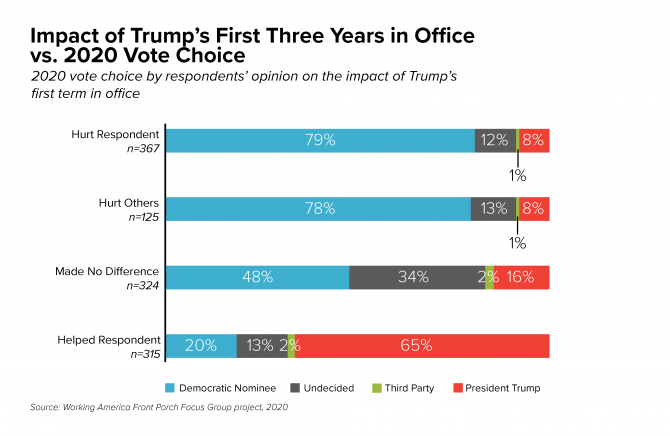
Voters who believe that Trump’s presidency has hurt them directly, or others they know, view this election as a referendum on his leadership and are likely to support the Democratic nominee by wide margins. Ironically, the more voters see his presidency as making no difference in their lives, the more open they are to supporting him.
We see other indications that some key segments of voters have begun to sour on Trump. Our canvassers also asked voters if they had changed their mind on any issue in the past three years. In Michigan in particular, we found that 1 in 5 working-class voters had changed their mind on Trump’s policies. Of that group, 7 in 10 plan to vote for the Democratic nominee.
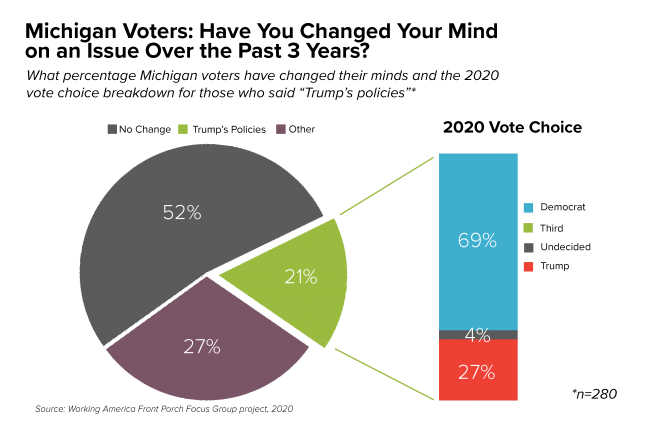
Erma, a 71-year-old Latinx woman in Phoenix, Arizona, said she was “open to the possibility that he could be a good president.” But now, she said, “I’m disgusted by America.” Another Phoenix, Arizona, resident, Lonnie, a 74-year-old African-American man, said, “I was open to Trump; now I’m definitely not.”
Kevin, a 54-year-old white Hudson, Wisconsin, resident, told our canvasser that he “really liked the Iran strike.” But when asked if he’s changed his mind on anything in the past three years, Kevin said his opinion on Trump’s policies has shifted, explaining, “I thought Trump would have done a better job.
When asked how he planned to vote in 2020, another Hudson, Wisconsin, resident, Dayton, a 73-year-old white man, said, “I’ve been voting Republican, but I’m not voting that way this time. I’m not sure who I’m going to vote for; I’m waiting for more people to drop out.” Carma, a 56-year-old white woman in Carleton, Michigan, said she changed her mind on Trump’s policies. “He’s an egotistical maniac,” Carma said, “and he treats people like crap.”
In our online tracking survey, 2016 Clinton voters in battleground states are unified in their disapproval of Trump and his policies. Trump so unifies these voters that news of divisive fights among Democratic primary campaigns does not appear to be costing many general election votes. Consistent with this consolidation: Those who backed third party candidates in 2016 are now more than twice as likely to pick the Democratic nominee as they are to stick with a third party.
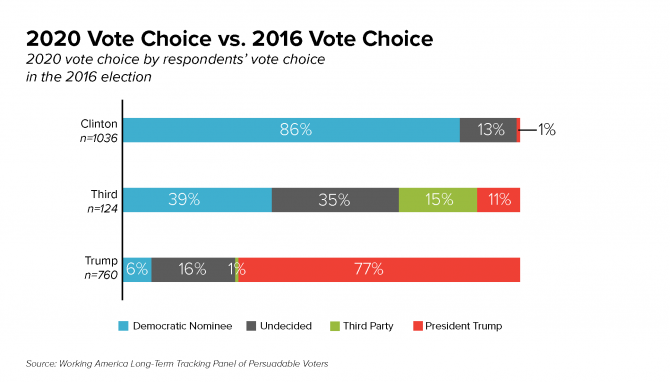
Our conversations with Democratic base voters echo the staunch opposition in our data. Juanita, a 43-year-old African-American woman in Detroit, Michigan, said, “[Trump] is an ass, and you can write that down. He is racist. The KKK came out to support him.” Kimberly, a 51-year-old white woman living in Burnsville, Minnesota, described Trump’s presidency as “a waiting game to see how much corruption our democracy can handle.” Michael, a 60-year-old white man living in Macomb County, Michigan, said, “Trump needs to get off social media and stop being a bully. He’s being childish and isn’t running this country like he should.”
The Trump tax plan is remarkably unpopular, showing surprising potential for voter persuasion against him. As part of our front porch interviews, canvassers also shared information on Trump’s tax overhaul and gauged voter opinion on the measure. Our canvassers said, “In his first term in office, Trump and the Republicans in Congress passed the Tax Cuts and Jobs Act. This new law resulted in workers earning over $625,000 per year getting nearly $50,000 per year in tax cuts. The average working person here in [state] earns [average state wage] per year and saw under $700 in benefits.” We then asked voters to rate the measure on a five-point scale, from strongly approve to strongly disapprove.
The chart below shows responses to that question, broken down by approval of Trump’s first term in office. Predictably, Democrats strongly disapproved of the Tax Cuts and Jobs Act. But among Republicans, only 40% agreed with the tax legislation. The feedback suggests that Democratic efforts to reverse the tax bill are fertile ground to further weaken Trump’s political support.
Connie, a 65-year-old white woman in Bristol, Pennsylvania, supported Trump. When asked about whether the Affordable Care Act should be repealed, she said, “I agree with whatever Trump wants to do.” Yet, when asked about Trump’s tax plan, Connie expressed disapproval, saying, “The 60K guy shouldn’t be paying as much as the rich guy.”
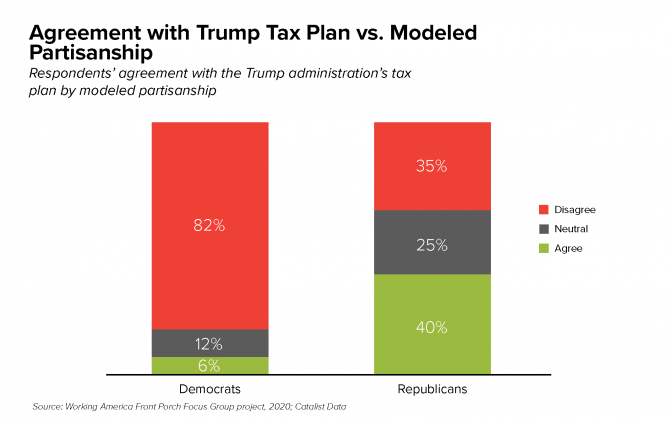
Looking at the same question across the partisan divide between rural and urban areas was equally damning. Regardless of the type of community where voters live, the tax law is overwhelmingly unpopular.
Throughout our conversations, voters described, in concrete terms, how they were affected by the changes to the tax code.
Nathan, a 33-year-old white man in Carleton, Michigan, told our canvasser he wasn’t sure how he would vote in 2020. Nathan felt that Trump was responsible for new jobs coming to his community. When the conversation turned to taxes, Nathan said, “He took away all of my travel benefits,” in reference to changes in deductions for work-related expenses like hotel costs. Nathan added, “My tax returns used to be around $10K, and last year it was $5,500.”
Njeri, a 47-year-old woman living in Philadelphia, Pennsylvania, said that Trump’s tax plan “seemed like a good idea in the paycheck, but tax refunds went down. In the long term, it’s not a good idea.”
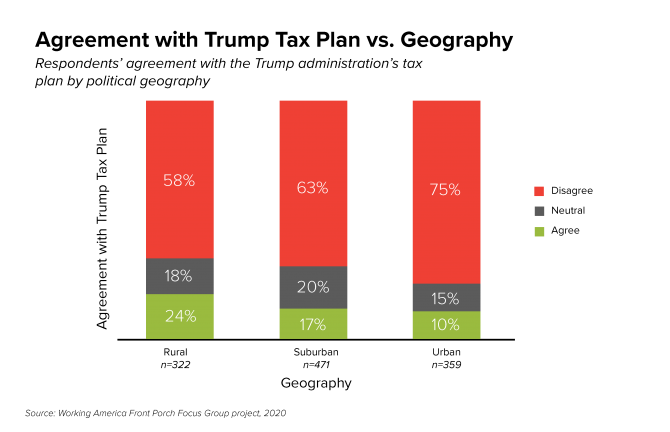
Another Bristol, Pennsylvania, resident, Thomas, a 57-year-old man, said that he wasn’t planning to vote for Democrats in 2020. But when asked whether Trump has helped or hurt his family, he said, “Trump has hurt me; his tax changes have cost me a lot of money. I used to be able to write off my second mortgage and the home equity. Now, I can’t.” When Trump’s tax plan came up again later, Thomas said, “People making $625,000 a year should be paying more than me.”
Geography, particularly the rural-urban divide, animated the partisan polarization of 2016. Small towns moved decidedly toward Trump while big metros shifted toward Democrats. In the elections since 2016, Democrats have made substantial gains in the suburbs — a major part of delivering the U.S. House, state legislatures and governorships. Despite differing political trends, voters in these communities have a shared vision of what needs to change.
In all geographies, access to affordable health care is the top issue entering 2020. Unlike
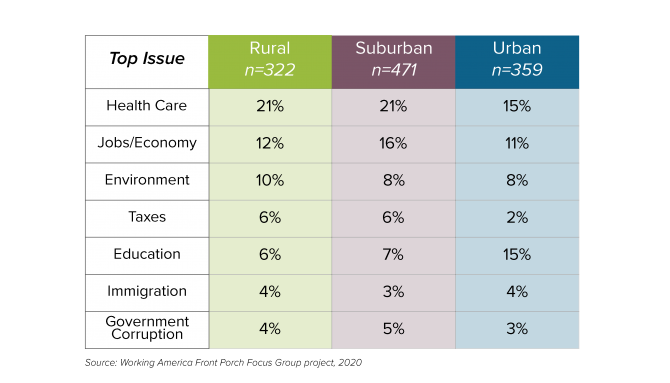
past presidential cycles, where the economy and foreign policy had a majority of voters’ attention, there are multiple issues voters are looking to address. The environment — even in more conservative rural communities, where Trump drove up his vote advantage — is one area of concern that has rising salience and is important to all geographies alike. While these voters may be dismissed as Trump’s base, our conversations find that there are quite a few voters open to voting for candidates who provide solutions on issues like climate change.
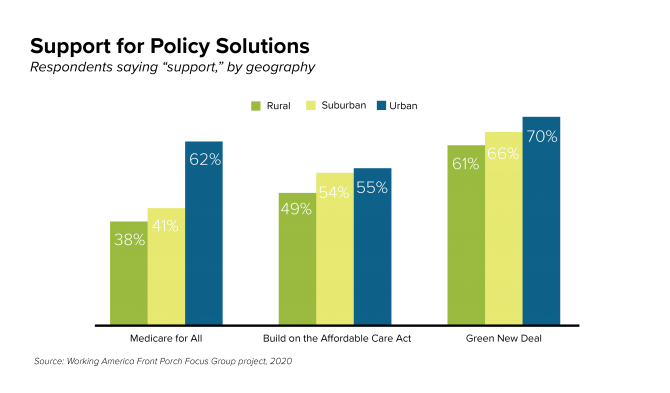
Support for Medicare for All is more tepid in more affluent suburbs (41%) and more conservative rural areas (38%). “Medicare for All isn’t going to work,” Steven, a 70-year-old white resident from Minnetonka, Minnesota, explained. “If I could click my ruby slippers
together to make that happen I would, but we could barely get the ACA passed.” Building on the ACA has almost majority support in all three geography types.
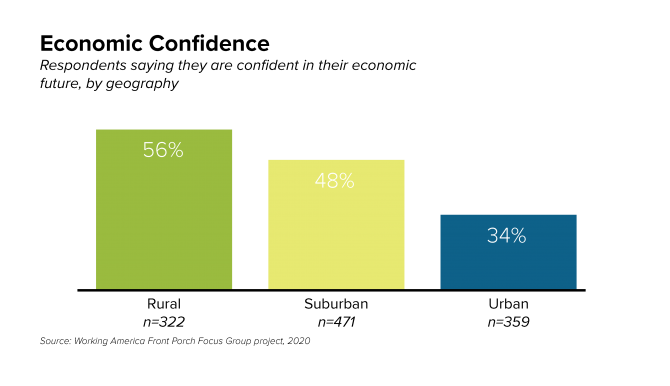
Despite macro-economic indicators (wage growth, declining unemployment, etc.) showing
positive growth in urban areas, urban voters do not feel the gains. Urban voters (34%) are the least likely of all voters we spoke with to say they are confident in their economic future.
We see evidence on matters like building a border wall and Medicare for All that race is strongly predictive of support or opposition. For example, voters of color are only about one-third as supportive of building a wall, even where migration may be seen through a lens of employment competition.
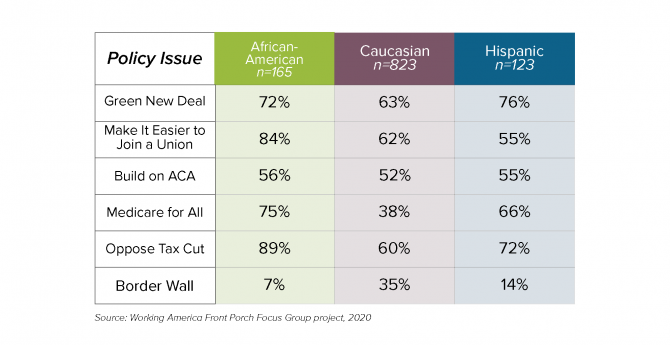
Whether the issue is expanding the ACA, addressing climate change or expanding the right to form a union, there is strong cross-racial appeal. Voters across race shared remarkably consistent views on these questions, underscoring the potential for the Democratic presidential nominee to run a unifying campaign around progressive values.
In discussions of health care, for example, there were common sentiments across race. Anselmo, a 49-year-old Latinx man and Phoenix, Arizona, resident, said, “Prices are so high, especially if you do not have health care, and either way medicines are too expensive.” Antoinette, a 45-year-old African-American woman in Detroit, Michigan, said, “I have insurance, but I take medication. A lot of people can’t afford insurance or their medication.” And Leona, a 74-year-old white woman in Carleton, Michigan, said, “You cannot depend on the price of prescription drugs to be consistent and affordable.”
While most voters feel Trump has done things that are grounds for his impeachment, many excuse his behavior as typical of politicians.
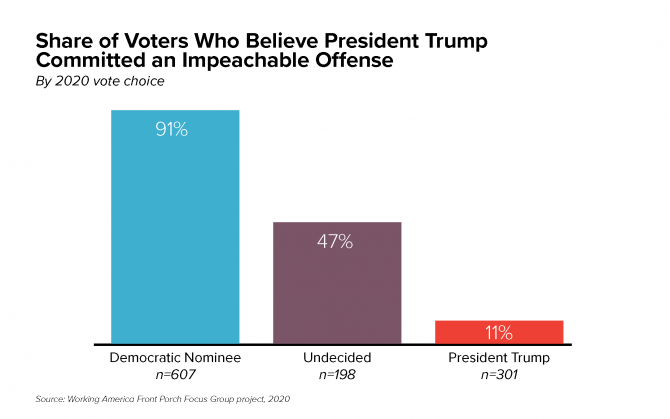
Throughout our Front Porch Focus Group report series started in 2016, canvassers have
spoken with people who are tuned out or fed up with the status quo. Cynicism about politicians and the possibility of meaningful change is pervasive. Unsurprisingly, Democratic base voters overwhelmingly believe that Trump has committed impeachable offenses. But impeachment doesn’t seem to have galvanized many except the most rabid Trump fans, who didn’t hesitate to decry the effort as a “witch hunt” or a hoax. Even some Trump supporters (1 in 10) told us that Trump has committed impeachable offenses. But these voters don’t see a contradiction between their support for Trump and their belief that he’s abused the powers of the office, because of their deep cynicism about politicians on the whole.
And the news isn’t good for Democrats, either. Antoinette, a 45-year-old African-American woman in Detroit, Michigan, said Trump has probably committed impeachable crimes, but added, “All politicians have something to hide. I think at the end of the day, every politician has probably done something impeachable.”
Leona, a retired 74-year-old white woman in Carleton, Michigan, said, “I think that if they uncovered all the stones in Washington, you will find more people who have done the same thing.”
Matthew, a 40-year-old white man and Tempe, Arizona, resident, said, “All presidents have done impeachable things.”
Many voters echoed these sentiments, excusing Trump’s behavior as commonplace among elected officials.
The election results this fall depend on whether progressives can win over working-class people across race and place. The Working America persuasion model, developed through dozens of experiments in a variety of electoral contexts, helps guide us toward reaching just those voters. Absent meaningful engagement, these infrequent or undecided voters may well stay home. Democrats can’t afford to lose these critical votes.
Among the pivotal constituencies in these battleground states, one thing is clear — this election is up for grabs. If you listen to inside-the-Beltway pundits, you would believe that voters are bitterly divided and rigorously committed to their political ideologies. Our view from the ground gives us a different perspective. By starting on people’s doorsteps and engaging them in face-to-face conversation, we help voters connect the dots between their personal experience and their political choices. Our approach centers on listening first, then introducing new information, rather than telling people that what they believe is wrong. Many of these working-class voters are simply struggling to make ends meet for their families, and they don’t always think in clear-cut ideological terms. Through authentic face-to-face engagement, however, Democrats can find common ground and win over these voters.
We use cookies and other tracking technologies on our website. Examples of uses are to enable to improve your browsing experience on our website and show you content that is relevant to you.